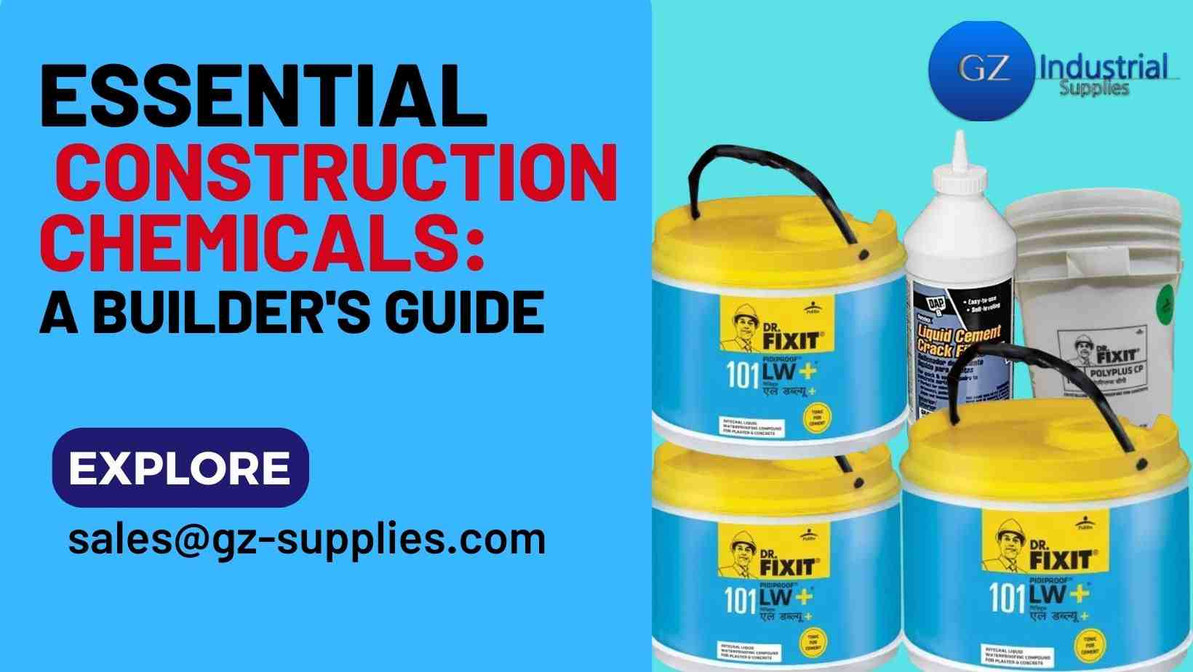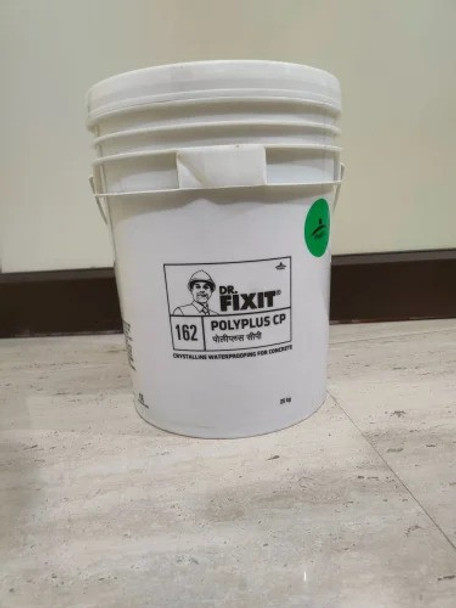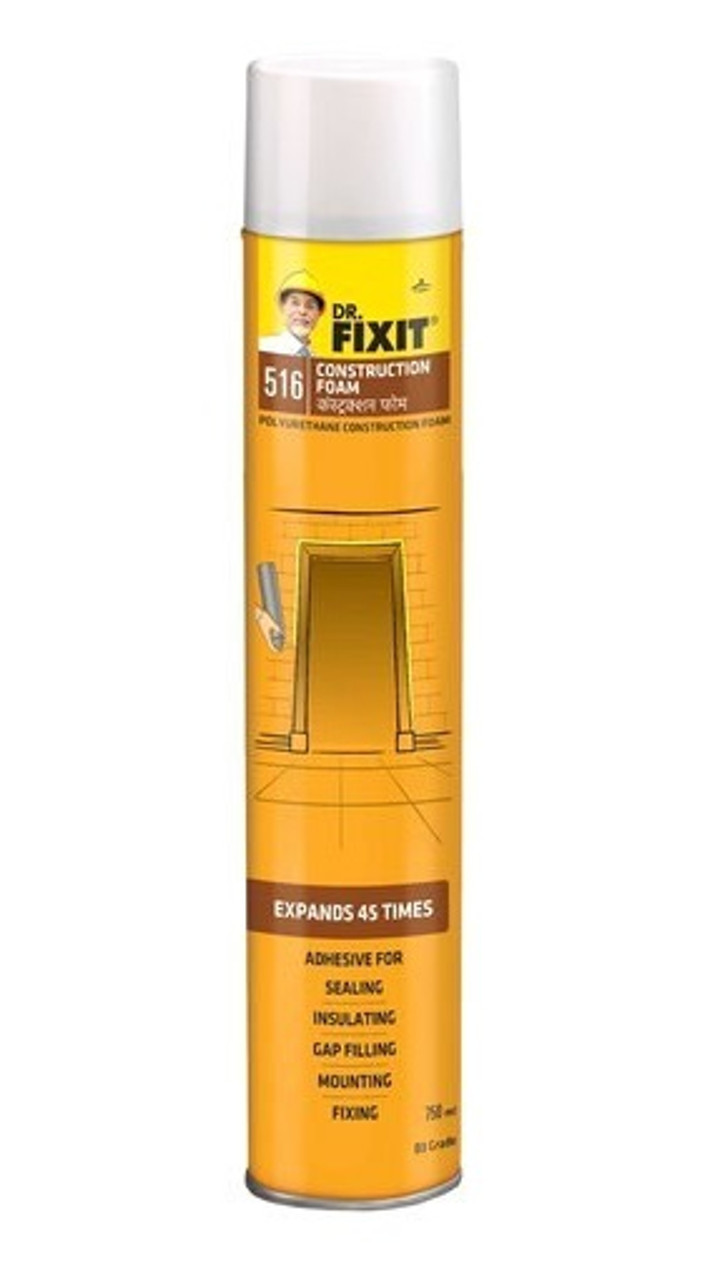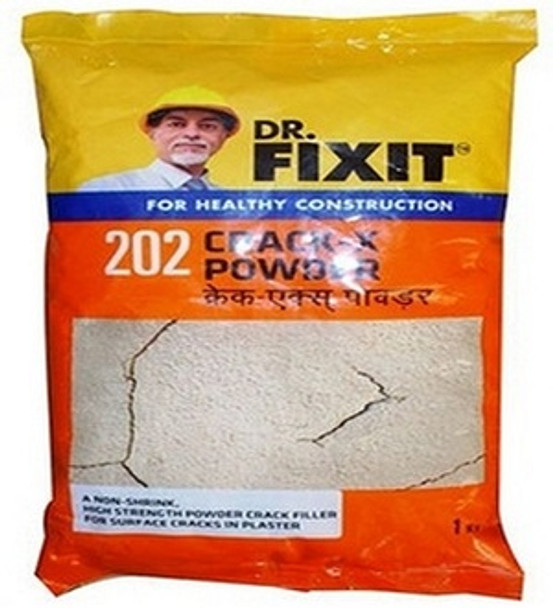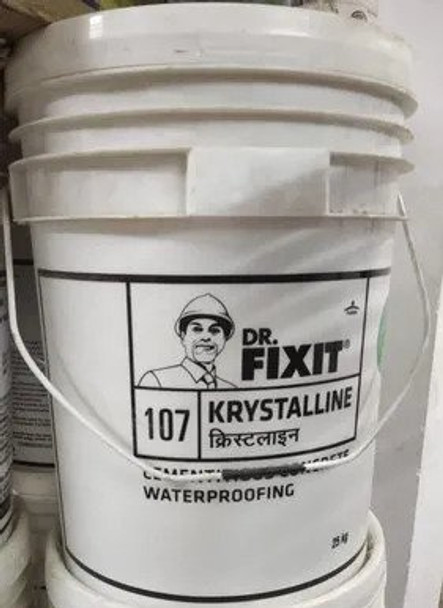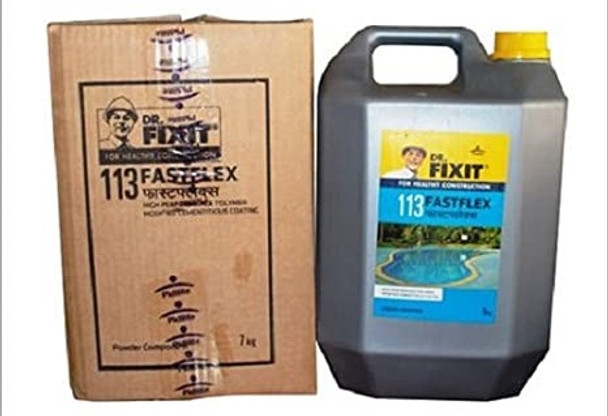Essential Construction Chemicals: A Builder's Guide
Key takeaway
Construction chemicals offer invaluable assistance in addressing the challenges posed by wet walls, which are often susceptible to moisture ingress and subsequent deterioration. Waterproofing agents, such as sealants and coatings, form a protective barrier on the surface of wet walls, preventing water infiltration and mitigating the risk of water-related damage. These chemicals effectively seal cracks, gaps, and pores in the wall substrate, thereby enhancing its impermeability and durability.
Buy Online... Dr Fixit Polyplus CP
Introduction
Construction chemicals have become indispensable assets within the construction industry with remarkable advancements in recent years. These innovative solutions have revolutionized construction processes, significantly enhancing the durability, aesthetics, and sustainability of buildings. There are a wide variety of construction chemicals ranging from adhesives, waterproofing agents, to concrete admixtures. Some are used to bond or seal surfaces, prevent water leakage or enhance the strength of the concrete.
One of the preferred construction chemicals used by builders is the Dr. Fixit Polyplus CPDr. Fixit Polyplus CP which is composed of high quality cement, properly selected & graded inert aggregates, proprietary waterproofing active chemicals & additives. It is used as a chemically active waterproofing treatment for concrete. Dr. Fixit POLYPLUS CP when mixed with water and applied as a brush coat to concrete, it penetrates deeply into the capillaries of the concrete & protects it against the permeability of water. Areas of Application are Water Retaining Structures such as Water tanks & reservoirs(Swimming pools, Water treatment works, Dams & canal and Concrete pipes) Harbours
In this comprehensive guide, we will embark on a journey through the world of construction chemical products. We will explore the vital role these products play, the various types available, their numerous applications in construction and how to choose the right construction chemicals for your project requirement. Whether you are a professional builder or a homeowner embarking on a renovation project, understanding the essentials of construction chemicals will empower you to make informed decisions, achieve optimal results, and ensure the longevity of your structures.
Top 5 Essential Construction Chemicals
1. Concrete Admixtures
Concrete admixtures are substances that are added to concrete before or during mixing to modify its properties according to the desired application. They play a crucial role in modern construction practices, enhancing the performance and workability of concrete mixtures. Concrete admixtures can be broadly categorized into various types based on their functions.
- Plasticizers: These admixtures improve the workability of concrete by reducing water content, making it easier to pour and mold.
- Accelerators: Accelerating admixtures are used to speed up the setting and curing time of concrete, which is particularly beneficial in cold weather conditions.
- Retarders: On the contrary, retarders slow down the setting time of concrete. This is useful in situations where extended workability is required.
- Water-Reducers: Water-reducing admixtures enhance the concrete's strength by reducing the amount of water needed, leading to a more robust final product.
- Air-Entraining Agents: These admixtures introduce microscopic air bubbles, improving the concrete's freeze-thaw resistance and durability.
Buy online.... Dr. Fixit Construction Foam 1 Carton
Benefits of Using Concrete Admixtures
Concrete admixtures offer several benefits for the construction industry, such as
- Improved Workability: Admixtures enhance the concrete's flowability, making it easier to handle and place, resulting in a smoother construction process.
- Strength Enhancement: Certain admixtures contribute to increased compressive strength and durability of the concrete, ensuring a longer lifespan for the structure.
- Time Savings: Accelerating admixtures can significantly reduce the setting time of concrete, allowing for faster construction schedules, saving both time and labour.
- Cost Efficiency: The optimized use of concrete admixtures can lead to reduced cement requirements, resulting in cost savings for builders.
Commonly Used Concrete Admixtures
Some of the examples of commonly used concrete admixtures are:
- Water-reducing admixtures: These are chemical admixtures that reduce the amount of water required to achieve a certain slump or consistency of concrete. They can be classified into three categories: normal, mid-range, and high-range (also known as superplasticizers). Water-reducing admixtures improve the workability and strength of concrete, and lower the heat of hydration and the risk of segregation and bleeding.
- Retarding admixtures: These are chemical admixtures that delay the initial setting time of concrete, allowing for more time for mixing, transporting, placing, and finishing. Retarding admixtures are useful for hot weather concreting, long haul distances, and complex or large-scale projects. They also reduce the peak temperature and the thermal cracking of concrete.
- Accelerating admixtures: These are chemical admixtures that speed up the setting and hardening time of concrete, allowing for faster removal of formwork and early loading of structures. Accelerating admixtures are useful for cold weather concreting, emergency repairs, and precast or prestressed concrete. They also increase the early strength and the frost resistance of concrete.
- Air-entraining admixtures: These are chemical admixtures that introduce microscopic air bubbles into the concrete mix, improving its workability and cohesion. Air-entraining admixtures also increase the durability and resistance of concrete to freezing and thawing cycles, deicing salts, and sulfate attack. They also reduce the density and the permeability of concrete.
- Mineral admixtures: These are finely divided materials that are added to concrete to replace or supplement some of the cement in the mix, such as fly ash, silica fume, ground granulated blast furnace slag, metakaolin, and rice husk ash. Mineral admixtures improve the strength, durability, and sustainability of concrete, and reduce the heat of hydration and the shrinkage of concrete.
Buy Online... Dr. Fixit 302 Super Latex 20Kg
2. Waterproofing Compounds
Waterproofing compounds are materials that prevent water from penetrating or damaging the surfaces of buildings, such as foundations, walls, roofs, and other parts. Waterproofing is crucial to protect the structural integrity, durability, and aesthetics of buildings, as well as to prevent health hazards caused by mold, mildew, and bacteria growth. Waterproofing also reduces the energy consumption and maintenance costs of buildings, as it prevents heat loss and corrosion.
Types of Waterproofing Compounds
There are different types of waterproofing compounds, depending on the materials, methods, and applications involved. Some of the common types are:
- Cementitious waterproofing: This is the simplest and most widely used type of waterproofing, as it is easy to mix and apply. It consists of cement, sand, and water-resistant additives that form a rigid or semi-flexible coating on the surfaces. Cementitious waterproofing is suitable for internal wet areas, such as bathrooms, kitchens, and basements, as well as for concrete structures, such as water tanks, dams, and bridges.
- Liquid waterproofing membrane: This flexible, liquid-applied membrane, is a thin coating that consists of a primer and two or more layers of liquid polymer that are applied by spray, roller, or trowel. It forms a flexible and seamless membrane that can adhere to various substrates and accommodate movements and cracks. Liquid waterproofing membrane is ideal for roofs, balconies, terraces, and other exposed areas, as it offers high resistance to weathering, UV rays, and chemicals.
- Bituminous coating and membrane: Bitumen-based compounds offer excellent water resistance and are commonly used in areas prone to heavy rainfall. Bitumen, a by-product of petroleum refining, is used as the main ingredient. Bitumen has excellent water-repellent and adhesive properties, but it becomes brittle when exposed to sunlight. Therefore, it is usually modified with polymers, such as polyurethane or acrylic, or reinforced with fibers, such as polyester or fiberglass, to enhance its flexibility and durability. Bituminous coating is applied as a liquid, while bituminous membrane is applied as a sheet or roll.
- Polyurethane liquid membrane: This is a type of waterproofing that uses polyurethane, a synthetic resin, as the main component. Polyurethane liquid membrane is applied as a liquid that cures into a rubber-like membrane that can stretch and recover. It has high elasticity, tensile strength, and crack-bridging ability, as well as excellent resistance to abrasion, puncture, and chemical attack. Polyurethane liquid membrane is suitable for flat roofs, decks, planters, and other areas that are subject to mechanical stress or frequent movement.
Buy online.... Dr. Fixit Pidiproof 101 LW + Waterproofing Chemical Plasticizer 1 Liter
Application Methods and Considerations
The application methods and considerations for waterproofing compounds depend on the type, location, and condition of the surfaces to be treated. Some of the general steps and factors to consider are:
- Surface preparation: This involves cleaning, repairing, and leveling the surfaces to remove any dirt, dust, oil, grease, loose particles, cracks, holes, or unevenness that may affect the adhesion and performance of the waterproofing compound. Surface preparation may require tools such as brushes, scrapers, sanders, grinders, or pressure washers. Pay special attention to sealing cracks and joints, as these are common points of vulnerability for water ingress.
- Primer application: Primer application is optional, and involves applying a thin layer of primer, which is a substance that improves the bonding and compatibility between the surface and the waterproofing compound. Primer application may be necessary for porous, absorbent, or non-compatible surfaces, such as wood, metal, or plastic.
- Waterproofing compound application: This involves applying the waterproofing compound according to the manufacturer’s instructions and specifications, such as the mixing ratio, curing time, coverage, thickness, and number of coats. Waterproofing compound application may require tools such as sprayers, rollers, trowels, brushes, or knives.
- Protection and finishing: This is a final step that involves applying a protective or decorative layer over the waterproofing compound, such as a paint, a sealant, a tile, or a gravel. Protection and finishing may be required to enhance the appearance, durability, or functionality of the waterproofed surface, such as to prevent fading, cracking, or slipping.
- Maintenance: Regular inspections and maintenance, will help identify potential issues early on, allowing for prompt repairs and the preservation of waterproofing efficacy.
Buy Online... Dr. Fixit Pidiproof 101 LW + Waterproofing Chemical Plasticizer 10 Liters
3. Sealants and Joint Fillers
Sealants and joint fillers are two different types of construction chemicals that are used to treat joints in concrete structures. Joints are intentional gaps or spaces that are created to allow for the movement, shrinkage, or expansion of concrete, as well as to relieve stress and prevent cracking. However, joints also expose the concrete to the infiltration of water, debris, and other harmful substances that can damage the structure or reduce its service life. Therefore, sealants and joint fillers are applied to joints to provide protection, support, and durability.
The main difference between sealants and joint fillers is their flexibility and function. Sealants are soft and elastic materials that can stretch and compress during the movement cycles of concrete joints. They prevent water and air from penetrating the joint, as well as reduce the noise and vibration transmission. Sealants are common in exterior joints, such as expansion, isolation, and construction joints, where high flexibility and weather resistance are required.
Joint fillers are semi-rigid and hard materials that can only accommodate slight movements. They provide support and protect the joint edges from chipping and spalling, as well as prevent the intrusion of incompressible materials and water to some extent. Joint fillers are suitable for interior joints, such as contraction joints, where low flexibility and edge protection are needed.
Types of Sealants and Joint Fillers
There are different types of sealants and joint fillers, depending on the chemical composition, properties, and applications. Some of the common types are:
- Polysulfide sealants: These are synthetic rubber sealants that have high elasticity, adhesion, and chemical resistance. They are ideal for joints that are exposed to fuels, oils, solvents, and corrosive substances, such as in airports, industrial plants, and wastewater facilities.
- Polyurethane sealants and fillers: These synthetic resin sealants and fillers have excellent durability, flexibility, and abrasion resistance. They are appropriate for joints that are subjected to mechanical stress or frequent movement, such as parking lots, bridges, and highways.
- Silicone sealants: Known for their flexibility and weather resistance, silicone sealants are synthetic polymer sealants that have high stability, flexibility, and weather resistance. They are excellent for joints that are exposed to extreme temperatures, UV rays, and moisture, such as in roofs, facades, and glazing systems.
- Epoxy fillers: These are synthetic resin fillers that have high strength, hardness, and adhesion. They are used for joints that require high load-bearing capacity and edge protection, such as in industrial floors, warehouses, and factories.
- Polyurea fillers: These are synthetic resin fillers that have high elasticity, toughness, and curing speed. They are used for joints that require fast installation and high performance, such as in cold storage facilities, food processing plants, and retail stores.
Buy online.... Dr. Fixit 603 Newcoat
Best Practices for Application
When it comes to sealant and joint filler application, best practices depend on the type, location, and condition of the joints to be treated. Some of the general steps and factors to consider are:
- Joint design: The first step has to do with determining the appropriate joint width, depth, spacing, and shape factor, based on the expected movement, load, and environmental conditions of the concrete structure. Joint design may require calculations, measurements, and drawings to ensure optimal performance and durability of the sealant or filler.
- Joint preparation: This includes cleaning, repairing, and priming the joint surfaces to remove any dirt, dust, oil, grease, loose particles, cracks, holes, or unevenness that may affect the adhesion and performance of the sealant or filler. Joint preparation may require tools such as brushes, scrapers, sanders, grinders, or pressure washers.
- Backer rod installation: This is an optional step that involves inserting a compressible and non-absorbent material, such as foam or rubber, into the joint to provide support and shape to the sealant. Backer rod installation may be necessary for joints that are too deep or wide, or that require an hourglass shape for the sealant. Backer rod installation may require tools such as knives, scissors, or guns.
- Sealant or filler application: This involves applying the sealant or filler according to the manufacturer’s instructions and specifications, such as the mixing ratio, curing time, coverage, thickness, and number of coats. Sealant or filler application may require tools such as caulking guns, pumps, spatulas, or trowels.
- Tooling and finishing: This is a final step that involves smoothing, shaping, and trimming the sealant or filler to ensure a neat and uniform appearance and seal. Tooling and finishing may require tools such as spatulas, knives, or solvents.
Sealants and joint fillers are essential construction chemicals that enhance the performance and value of concrete structures. By choosing the right type and applying it properly, sealants and joint fillers can ensure the long-term protection and durability of any joint.
Buy online... Dr. Fixit 202 Crack-X Powder (1 carton)
4. Surface Treatments
Surface treatments are essential in construction for enhancing the durability and aesthetic appeal of various materials. Understanding the purpose, benefits, types, and application techniques is crucial for builders looking to optimize the performance and appearance of surfaces in their projects. They serve multiple purposes and offer a range of benefits that contribute to the overall performance and aesthetics of construction materials such as:
- Protection: Surface treatments create a protective layer, shielding materials from environmental factors such as UV rays, moisture, and chemical exposure, thereby preventing degradation.
- Improved Durability: By reinforcing the surface, these treatments enhance the material's resistance to wear, abrasion, and other forms of damage, ensuring a longer lifespan.
- Aesthetic Enhancement: Surface treatments can enhance the appearance of materials by providing a consistent finish, highlighting natural textures, or adding color for decorative purposes.
- Maintenance Reduction: Treated surfaces are often easier to clean and maintain, reducing the need for frequent repairs and upkeep.
Different Types of Surface Treatments
Several types of surface treatments cater to different materials and construction requirements:
- Sealers: Penetrating sealers protect materials such as concrete and masonry by repelling water and preventing the penetration of contaminants. Surface sealers provide a protective layer on the material's surface.
- Coatings: Coatings, such as paint and epoxy, offer a protective and decorative finish. Epoxy coatings are commonly used for concrete floors, providing a durable and aesthetically pleasing surface.
- Anti-Graffiti Coatings: These coatings act as a barrier against graffiti, making it easier to remove unwanted markings without causing damage to the underlying surface.
- Corrosion Inhibitors: Applied to metal surfaces, corrosion inhibitors form a protective layer that prevents rust and corrosion, extending the lifespan of structures.
Buy Online... Dr Fixit Raincoat 601 20L
Application Techniques and Considerations
Effective application of surface treatments requires careful consideration of the material type, environmental conditions, and desired outcome:
- Surface Preparation: Properly clean and prepare the surface before applying any treatment to ensure maximum adhesion and effectiveness.
- Compatibility: Select surface treatments that are compatible with the material being treated. For example, choose a sealer that suits the porosity of the concrete or a coating designed for specific surfaces.
- Environmental Factors: Consider weather conditions and temperature during application. Some treatments may require specific conditions for optimal results. Ideally, a dry and warm day with low humidity and wind is preferred.
- Binder and aggregate application: This involves applying the binder and aggregate according to the manufacturer’s instructions and specifications, such as the mixing ratio, curing time, coverage, thickness, and number of coats. The binder and aggregate should also be applied at the optimal temperature and rate to achieve the desired quality and performance.
- Quality control and assurance: This involves testing and inspecting the materials and the finished surface treatment to ensure that they meet the design and performance requirements.
Buy Online... Dr Fixit Krystalline 107
5. Repair and Rehabilitation Materials
Repair and rehabilitation materials are construction chemicals that are used to restore, improve, or modify the structural or functional properties of damaged or deteriorated buildings and structures. Repair and rehabilitation are important in construction because they can:
- Enhance the safety, performance, and durability of the buildings and structures, as well as prevent further deterioration or collapse.
- Extend the service life and reduce the maintenance costs of the buildings and structures, as well as avoid the need for demolition and reconstruction.
- Preserve the historical, cultural, or aesthetic value of the buildings and structures, as well as comply with the codes and standards of the relevant authorities and agencies.
Types of Repair and Rehabilitation Materials
There are different types of repair and rehabilitation materials, depending on the nature, extent, and cause of the damage or deterioration, as well as the desired outcome and budget of the project. Some of the common types are:
- Concrete repair materials: Specifically designed to repair and restore damaged concrete surfaces, such as cracks, spalls, delaminations, or honeycombs. Concrete repair materials include cementitious mortars, epoxy mortars, polymer-modified mortars, micro-concrete, and shotcrete.
- Steel repair materials: These are materials that are used to repair or replace corroded or damaged steel elements, such as rebars, beams, columns, or bolts. Steel repair materials include epoxy resins, epoxy-coated rebars, stainless steel rebars, mechanical anchors, and cathodic protection systems.
- Strengthening materials: These are used to increase the load-bearing capacity, stiffness, or ductility of the existing structural elements, such as slabs, beams, columns, or walls. Strengthening materials include steel plates, steel fibers, carbon fibers, glass fibers, and ferrocement.
- Waterproofing materials: These are materials that are used to prevent or reduce the penetration of water or moisture into the buildings and structures, which can cause corrosion, cracking, or biological growth. Waterproofing materials include bituminous coatings, bituminous membranes, liquid membranes, cementitious coatings, and crystalline admixtures.
- Protective coatings: These are materials that are used to protect the surface of the buildings and structures from the effects of weathering, UV rays, chemicals, abrasion, or impact. Protective coatings include paints, sealants, varnishes, and anti-graffiti coatings.
Buy Online... Dr. Fixit Powder Waterproof (1 Carton)
Guidelines for Proper Usage of Construction chemicals
Construction chemicals, like any other chemicals, can pose various health and environmental hazards if not handled properly. Therefore, it is essential to follow some basic safety precautions and handling instructions when using construction chemicals, such as:
- Always read the labels and refer to the material safety data sheets (MSDSs) to identify the properties and hazards of the construction chemicals, as well as the recommended personal protective equipment (PPE), first aid measures, and disposal methods.
- Use the proper PPE, such as gloves, goggles, masks, and boots, when handling construction chemicals. Old or damaged PPE should be replaced, and the PPE should be inspected prior to each use.
- Ensure you employ the proper control measures, such as ventilation hoods, fume extractors, or spill kits, when handling construction chemicals. These measures should be routinely inspected and maintained to ensure their effectiveness.
- Follow the manufacturer’s instructions and specifications when mixing, applying, curing, or storing construction chemicals. Do not use expired, contaminated, or incompatible chemicals, and do not alter the chemical composition or ratio.
- Keep the work area clean and organized, and dispose of any waste or excess chemicals in a safe and responsible manner, according to the local regulations and guidelines.
- Always wash thoroughly with soap and water after handling any construction chemical, and seek medical attention if any symptoms of exposure or irritation occur.
- Familiarize yourself and workers with emergency procedures, including first aid measures, in case of accidental exposure or spills.
Storage and shelf life considerations
Construction chemicals, like any other chemicals, can deteriorate or lose their effectiveness if not stored properly. Therefore, it is important to consider some storage and shelf life factors when using construction chemicals, such as:
- Store construction chemicals in their original and properly labelled containers, and do not transfer or reuse containers without adequate cleaning and labelling.
- Always store construction chemicals in a secure, dry, cool, and well-ventilated area, away from direct sunlight, heat sources, ignition sources, or incompatible materials.
- Always check the expiry date and the physical condition of the construction chemicals before using them, and do not use any chemical that shows signs of degradation, such as discoloration, sedimentation, separation, or crystallization.
- Follow the manufacturer’s recommendations and specifications regarding the shelf life and storage conditions of the construction chemicals, and do not exceed the maximum storage time or temperature.
- Always keep an inventory and a record of the construction chemicals in storage, and use the first-in first-out (FIFO) principle to ensure the optimal use and rotation of the chemicals.
Compatibility with other construction materials
Construction chemicals, like any other chemicals, can react or interact with other materials in different ways, depending on their chemical composition, properties, and functions. Therefore, it is essential to consider the following:
- Compatibility Testing: Perform compatibility testing before applying construction chemicals to substrates, ensuring that they do not negatively react with the existing materials.
- Adhesion Compatibility: Ensure proper adhesion compatibility when using adhesives or sealants, especially when bonding different materials such as metals, plastics, or concrete.
- Avoid Contamination: Prevent contamination by keeping construction chemicals away from incompatible substances. This includes separating chemicals during storage and application.
- Consult Manufacturer Guidelines: Manufacturers often provide guidelines on the compatibility of their products with specific materials. Refer to these guidelines for accurate information.
Buy Online... Dr. Fixit 113 Fastflex
97% of people like to read
Where to Buy Construction Chemicals in Nigeria
Conclusion
Construction chemicals are vital components of any construction project, as they provide various benefits and solutions to the challenges and demands of the construction industry. Construction chemicals can enhance the quality, performance, and durability of the buildings and structures, as well as reduce the environmental impact and cost of the construction process.
In this article, we have discussed some of the essential construction chemicals that every builder should know, such as: Admixtures, Waterproofing compounds,Sealants and joint fillers, Surface treatments as well as Repair and rehabilitation materials
We have also provided some guidelines for the proper usage of construction chemicals, such as the safety precautions and handling instructions, the storage and shelf life considerations, and the compatibility with other construction materials.
We hope that this article has given you a comprehensive overview of the essential construction chemicals and their applications and benefits. Construction chemicals are a valuable asset for any builder who wants to achieve the best results and outcomes for their projects.
If you want to learn more about construction chemicals, or if you need any assistance or consultation for your construction projects, please feel free to contact us @ gz-supplies.com
Recent Posts
-
Top Selling Magnetic Drilling Machines in Nigeria
Magnetic Drilling Machine is a portable drilling machine with a magnetic base (either electroma …Mar 31, 2025 -
Industrial Drilling Machines: Boosting Productivity and Efficiency
Key Takeaway Industrial drilling machines are indispensable power tools that significantly enha …Mar 31, 2025 -
THE BEST MAGNETIC DRILLING MACHINE IN NIGERIA 2025 REVIEWS
Introduction: Contemporary trends in technology make it pretty effortless to perform complex ex …Mar 31, 2025

